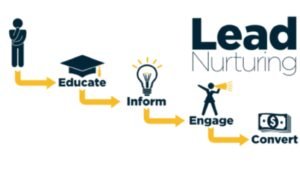
In today’s digital-first world, having an effective B2B content marketing strategy is essential for any business wanting to stay competitive, reach potential clients, and build relationships. With businesses generating three times more leads through content marketing than traditional marketing while cutting costs by 62%, B2B companies need a strong content strategy to drive results. In this post, we’ll explore the eight key steps you need to develop a successful B2B content marketing strategy that helps you achieve your goals.
What is B2B Content Marketing?
Before diving into the steps, it’s important to understand what B2B content marketing is. At its core, B2B content marketing involves creating and distributing content that is specifically designed to educate, engage, and convert other businesses or professionals. Unlike B2C (business-to-consumer) content marketing, which focuses on reaching individual consumers, B2B content is aimed at organizations and professionals, helping them make better business decisions.
A well-executed B2B content marketing strategy typically revolves around a content marketing funnel, which includes three key stages:
- Awareness: Your audience first becomes aware of your brand or product.
- Consideration: They start exploring your solutions and comparing them with others.
- Decision: They are ready to purchase, and your content helps finalize their choice.
Now, let’s get into the actionable steps to build your strategy.
8 Steps to Create an Effective B2B Content Marketing Strategy
1. Identify the Buyer’s Persona
Creating a B2B content marketing strategy starts with defining your buyer persona—a detailed profile of your ideal customer. Understanding your audience’s pain points, interests, and needs allows you to tailor your content and messaging accordingly. Here’s what you should identify for each buyer persona:
- Who is your target audience?
- What are their demographics?
- What are their professional needs or challenges?
- What content will resonate with them?
Understanding the buyer’s journey—how they move from awareness to decision—helps ensure your content addresses their needs at every stage.
2. Create Content for All Stages of the Funnel

It’s important to create content that aligns with every stage of the B2B content marketing funnel. Here’s how you can break it down:
- Awareness Stage: At the top of the funnel, create content that educates and builds brand awareness. Blog posts, infographics, and introductory videos are ideal for this stage.
- Consideration Stage: Here, your prospects are evaluating their options. Consider creating comparison guides, whitepapers, or case studies to showcase the benefits of your products or services.
- Decision Stage: In the final stage, your prospects are ready to make a purchasing decision. Use product demos, client testimonials, and pricing comparisons to seal the deal.
By addressing the needs of your target audience at every stage, you increase your chances of converting leads into customers.
3. Content Distribution
Even the best content won’t yield results if it doesn’t reach the right audience. An effective content distribution strategy involves leveraging owned, earned, and paid media:
- Owned Media: This includes your blog, website, and social media channels. Optimize these platforms to showcase your expertise.
- Earned Media: This comes from third-party mentions, such as media coverage, reviews, or social shares. It’s a great way to build credibility.
- Paid Media: Use paid search, social media ads, and display ads to promote your high-value content and target new prospects.
After distributing content, track its performance on each channel to refine your strategy over time.
4. Create Content for Lead Nurturing

Lead nurturing is critical in a B2B content marketing strategy, especially considering the longer sales cycles. The goal is to consistently engage with your leads, providing relevant content that helps them move closer to purchasing. To do this, create content that addresses their pain points at each stage of the buyer journey:
- Educational blog posts that provide insights into industry trends or solutions.
- Webinars that allow for real-time engagement with your audience.
- Case studies that showcase how your products or services have successfully helped other businesses.
Consistent, high-quality content keeps your leads engaged and encourages them to move down the funnel.
5. Create Lead Magnets
A lead magnet is a valuable piece of content that you offer in exchange for a user’s contact information, such as an email address. This helps build your email list and nurtures potential clients further. Common lead magnets include:
- Ebooks or guides
- Exclusive webinars or tutorials
- Checklists or templates
- Free trials or demos
Ensure that your lead magnet is relevant to your target audience’s needs and provides a clear benefit. Promote it through various channels, including social media, your website, and paid ads.
6. Measure the Effectiveness of Your Content
To know whether your B2B content marketing efforts are working, it’s essential to track performance using key metrics. Here are some useful KPIs:
- Time on page: Are users spending enough time engaging with your content?
- Pages per session: Are they navigating to more pages after consuming a piece of content?
- Conversions: How many leads are generated from your content pieces?
- Social shares and comments: This helps gauge the virality and engagement of your content.
Use tools like Google Analytics, HubSpot, or SEMrush to monitor and evaluate your content performance. Make adjustments based on the data to optimize future efforts.

7. Optimize the Content
Your content should be optimized for search engines (SEO) to attract more organic traffic. Begin by conducting keyword research to understand what terms your target audience is searching for. Ensure that your content is well-structured, informative, and optimized with relevant keywords.
Additionally, ensure that your content is easy to read by using bullet points, headers, short paragraphs, and images to break up text. This not only makes your content SEO-friendly but also enhances user experience.
8. Prioritize Link Building and Collaboration
Link building is one of the most effective ways to increase your website’s authority and improve its rankings on search engines. By earning backlinks from reputable sites, you signal to search engines that your content is valuable.
Additionally, consider collaborating with industry influencers or other businesses to co-create content. Guest blog posts, joint webinars, and partnerships can expand your content’s reach, opening new avenues for traffic and leads.
Conclusion
Developing a strong B2B content marketing strategy requires careful planning and execution, but the rewards are well worth the effort. By following these 8 steps, you can create content that resonates with your audience, drives meaningful engagement, and ultimately leads to more conversions. Stay flexible, keep measuring results, and continue optimizing your strategy for the best results.
Ready to take your B2B content marketing strategy to the next level? Start implementing these steps today, and watch your leads grow and your ROI increase.